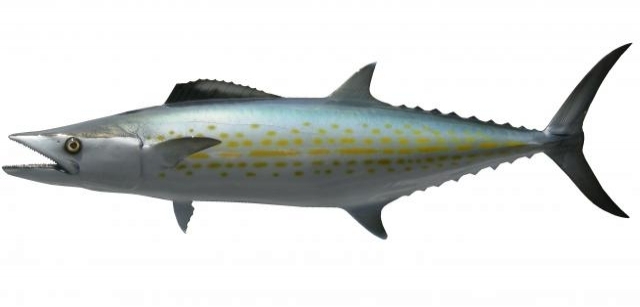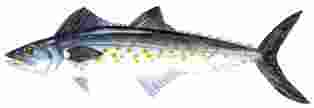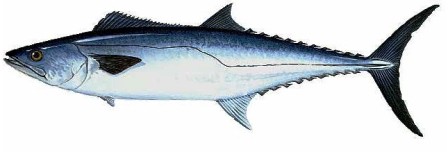Discover Florida Nature
It's time to explore the natural Florida


|
|
|
|
|
 Cero
(Scomberomorus regalis) Cero are especially common in the
Caribbean, Bahamas, and Florida. Cero mackerel are found over coral
reefs, wrecks, and along ledges in depths ranging from the water's
surface to mid-water. Cero mackerel primarily feed on small schooling
fish, particularly clupeid fish such as herrings. They also eat
silversides, squid, and shrimp. Cero mackerel is a popular recreational
fish but has minor commercial importance. They are taken as bycatch in
other commercial fisheries. They are not known to form large schools and
are more difficult to target individually. In general, they do not make
up a significant amount of coastal pelagic catches. Cero is silvery
below and dark blue above. A blackish band runs on the side from the
base of the pectoral fin nearly to the base of the caudal fin, crossing
the lateral line. Below the band are rows of oblong gold spots. Cero
grow up to 32 inches in length and 11 pounds in weight. Spawning occurs
offshore during April through October off Jamaica, in midsummer off the
coast of Florida, and year-round in Puerto Rican waters. Cero
(Scomberomorus regalis) Cero are especially common in the
Caribbean, Bahamas, and Florida. Cero mackerel are found over coral
reefs, wrecks, and along ledges in depths ranging from the water's
surface to mid-water. Cero mackerel primarily feed on small schooling
fish, particularly clupeid fish such as herrings. They also eat
silversides, squid, and shrimp. Cero mackerel is a popular recreational
fish but has minor commercial importance. They are taken as bycatch in
other commercial fisheries. They are not known to form large schools and
are more difficult to target individually. In general, they do not make
up a significant amount of coastal pelagic catches. Cero is silvery
below and dark blue above. A blackish band runs on the side from the
base of the pectoral fin nearly to the base of the caudal fin, crossing
the lateral line. Below the band are rows of oblong gold spots. Cero
grow up to 32 inches in length and 11 pounds in weight. Spawning occurs
offshore during April through October off Jamaica, in midsummer off the
coast of Florida, and year-round in Puerto Rican waters. Spanish
Mackerel
(Scomberomorus maculatus) The Spanish mackerel is
much smaller than its relative, the king mackerel. Spanish mackerel will
grow to 27 inches long and 12 pounds, although the average is less than
one-third that. Smaller fish are more common inshore. Spanish mackerel
are greenish dorsally with silver sides and belly. Yellow or olive oval
spots traverse the body, which is covered with very tiny scales. The
Spanish mackerel is found in water temperatures above 68° F. Unlike king
mackerel, the Spanish mackerel do not appear to move freely around the
Florida Keys, creating two subpopulations, one in the Gulf and the other
off the southeastern states. Spanish mackerel are fast growing, and may
live to be 8 years old. Both sexes are capable of reproduction by the
second year. Spawning occurs from April to September off the North
Carolina and Virginia coasts. Spanish mackerel are sight feeders. Most
of the time you'll find the this mackerel feeding in a band of clear,
clean water, and depending on wind and location, that can be anywhere
from just off the surf to several miles off the beach. Feeding Spanish
mackerel are often seen forcing schools of small fish into tight bundles
and nearly pushing them out of the water. Spanish mackerel are schooling
predators that relentlessly attack schools of smaller fish, especially
anchovies. By far, the most productive way to catch Spanish mackerel is
trolling in a small boat, because you can move to the fish in most
cases. Spanish
Mackerel
(Scomberomorus maculatus) The Spanish mackerel is
much smaller than its relative, the king mackerel. Spanish mackerel will
grow to 27 inches long and 12 pounds, although the average is less than
one-third that. Smaller fish are more common inshore. Spanish mackerel
are greenish dorsally with silver sides and belly. Yellow or olive oval
spots traverse the body, which is covered with very tiny scales. The
Spanish mackerel is found in water temperatures above 68° F. Unlike king
mackerel, the Spanish mackerel do not appear to move freely around the
Florida Keys, creating two subpopulations, one in the Gulf and the other
off the southeastern states. Spanish mackerel are fast growing, and may
live to be 8 years old. Both sexes are capable of reproduction by the
second year. Spawning occurs from April to September off the North
Carolina and Virginia coasts. Spanish mackerel are sight feeders. Most
of the time you'll find the this mackerel feeding in a band of clear,
clean water, and depending on wind and location, that can be anywhere
from just off the surf to several miles off the beach. Feeding Spanish
mackerel are often seen forcing schools of small fish into tight bundles
and nearly pushing them out of the water. Spanish mackerel are schooling
predators that relentlessly attack schools of smaller fish, especially
anchovies. By far, the most productive way to catch Spanish mackerel is
trolling in a small boat, because you can move to the fish in most
cases.  King
Mackerel
(Scomberomorus cavalla) King mackerel are a "coastal pelagic"
species, meaning they live in the open waters near the coast. The
mackerels are true members of the tuna family and are Western Atlantic
species. Although the Kings don’t have the endurance of the tuna, they
are unmatched for their speed and agility. They are found both nearshore
and offshore and are common form North Carolina to Brazil. They are
found at depths of 115 to 591 feet. They have preference for water
temperature above 20deg.C (68deg. F) and salinity ranging from 32 to 36
ppt. King
Mackerel
(Scomberomorus cavalla) King mackerel are a "coastal pelagic"
species, meaning they live in the open waters near the coast. The
mackerels are true members of the tuna family and are Western Atlantic
species. Although the Kings don’t have the endurance of the tuna, they
are unmatched for their speed and agility. They are found both nearshore
and offshore and are common form North Carolina to Brazil. They are
found at depths of 115 to 591 feet. They have preference for water
temperature above 20deg.C (68deg. F) and salinity ranging from 32 to 36
ppt.The king mackerel is a slender, streamlined fish, slightly flattened from side to side with a tapered head. Its color ranges from an iridescent bluish green on its back to its silvery sides. Two dorsal fins can fold back in to a groove to enhance speed, short pectoral fins on each side just behind the head; pelvic fins below the pectorals and a row of small finlets extend from the dorsal and anal fins to the tail. The lateral line starts near the top of each gill drops sharply below the second dorsal fin and ends near the tail. King mackerel are constantly feeding carnivores that can attack with high speed, powerful jaws and razor-like teeth. They feed on all and any available food but favor jacks, sea trout, sardine like fishes, ribbonfish, herring, shrimp and squid. The King Mackerel is a schooling and migrating fish that spends the winter months in south Florida and moves to more northerly waters in spring and summer. The Gulf population is considered to be separate from the Atlantic population. The separate populations are thought to mix in the winter months from east central Florida southward past Key West. Spawning occurs in mid-summer north of Miami in the Atlantic and the northern area of the Gulf of Mexico. King mackerel are a highly sought after game fish. They are a challenging catch that puts up a spectacular fight by leaping and sky rocketing out of the water. The record catch for a king mackerel in Florida is ninety pounds. Predators targeting smaller king mackerel include juvenile and larger pelagic fishes; predators targeting adults include bottlenose dolphin and larger fish such as sharks and tuna. |
|
|
Advertise | Privacy Statement | Dog Encyclopedia | Video |Contact | Alaska Nature |
|